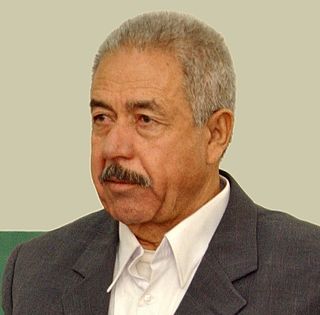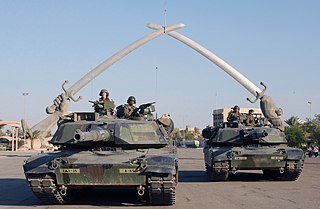 W
WAl-Shaheed Monument, also known as the Martyr's Memorial, is a monument designed by Iraqi sculptor, Ismail Fatah Al Turk, and is situated in the Iraqi capital, Baghdad. It is dedicated to the Iraqi soldiers who died in the Iran–Iraq War. However, now it is generally considered by Iraqis to be a commemoration of all of Iraq's martyrs not just of the Iran–Iraq War.
 W
WThe Iraqi Air Force is the aerial warfare service branch of the Iraqi Armed Forces, responsible for the policing of international borders and surveillance of national assets. The IQAF also acts as a support force for the Iraqi Navy and the Iraqi Army, and it allows Iraq to rapidly deploy its developing Army.
 W
WThe Iraqi Armed Forces consist of the Iraqi Army, the Iraqi Air Force, and the Iraqi Navy.
 W
WSaddam Hussein (1937–2006) initiated an extensive biological weapons (BW) program in Iraq in the early 1980s, in violation of the Biological Weapons Convention (BWC) of 1972. Details of the BW program—along with a chemical weapons program—surfaced only in the wake of the Gulf War (1990–91) following investigations conducted by the United Nations Special Commission (UNSCOM) which had been charged with the post-war disarmament of Saddam's Iraq. By the end of the war, program scientists had investigated the BW potential of five bacterial strains, one fungal strain, five types of virus, and four toxins. Of these, three—anthrax, botulinum and aflatoxin—had proceeded to weaponization for deployment. Because of the UN disarmament program that followed the war, more is known today about the once-secret bioweapons program in Iraq than that of any other nation.
 W
WIn violation of the Geneva Protocol of 1925, the Iraqi Army initiated two failed and one successful (1978–1991) offensive chemical weapons (CW) programs. President Saddam Hussein (1937–2006) pursued the most extensive chemical program during the Iran–Iraq War (1980–1988), when he waged chemical warfare against his foe. He also used chemicals in 1988 in the Al-Anfal Campaign against his civilian Kurdish population and during a popular uprising in the south in 1991.
 W
WThe Iraqi Perspectives Project is a research effort conducted by United States Joint Forces Command, focusing on Operation Iraqi Freedom.
 W
WThe Ministry of Defence is the Iraqi government agency responsible for defence of Iraq. It is also involved with internal security.
 W
WThe Monument to the Unknown Soldier is a monument in central Baghdad built by Italian architect Marcello D'Olivo based on a concept by Iraqi sculptor Khaled al-Rahal and constructed between 1979 and 1982. It was dedicated to the martyrs of the Iran–Iraq War. In 1986 the national square of Iraq, Great Celebrations square, was built near the monument, and two other monuments were built close to the square in memory of the matyrs. In 1983, the Al-Shaheed Monument on the River, was opened and in 1989 the newly built Victory Arch became the entrances to the square. The Unknown Soldier's Monument represents a traditional shield (dira¹a) dropping from the dying grasp of an Iraqi warrior. The monument also houses an underground museum.
 W
WThe Iraqi National Guard was part of the new Military of Iraq but has since been absorbed by the Iraqi Army controlled by the interim government. Following the 2003 invasion of Iraq, United States Coalition Provisional Authority Chief Paul Bremer disbanded the military apparatus of Iraq as existed under Saddam Hussein. As the security situation in occupied Iraq deteriorated and the Iraqi insurgency became increasingly active, the U.S. set up, recruited and trained the new security force in order to combat the insurgency. Despite attacks by insurgent and terrorist groups, the Iraqi National Guard was able to recruit many Iraqis from the vast ranks of the unemployed. The force has been used to assist Coalition troops in combatting the insurgency. However, there have been several instances where they have refused to take military action against fellow Iraqis, such as in Fallujah, deserted, or allegedly aided the resistance.
 W
WThe Iraqi Republican Guard was a branch of the Iraqi military from 1964 to 2003, primarily during the presidency of Saddam Hussein. It later became the Republican Guard Corps, and then the Republican Guard Forces Command (RGFC) with its expansion into two corps. The Republican Guard was disbanded in 2003, after the invasion of Iraq by a U.S.-led international coalition.
 W
WThe Iraqi Special Republican Guard (SRG), also known as the Special Forces Brigade of the Presidential Palace, Republican Guard Special Protection Forces, or the Golden Division, was an Iraqi personal security force founded in either early 1992 or March 1995 in Ba'athist-era Iraq. The Special Republican Guard was controlled by the Special Security Organization and charged with protecting President Saddam Hussein, presidential sites, Baghdad, and responding to any rebellion, coup, or other threat to his power.
 W
WTanks have been utilized in Iraq both within the military and within several conflicts with their usage and origin after World War II; the Cold War; and the modern era. This includes imported Soviet tanks as well as British designs imported after World War II, and current American ones.